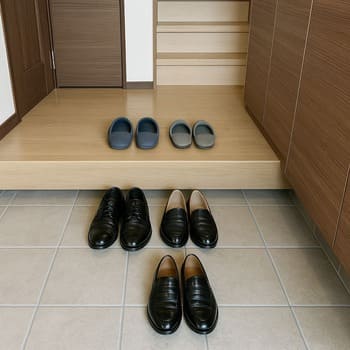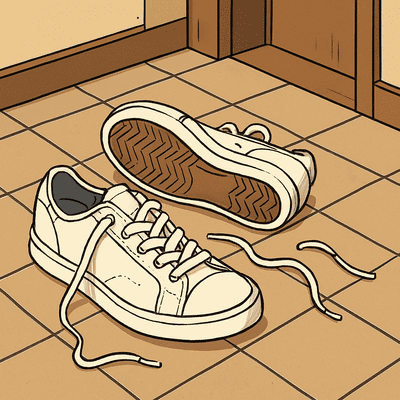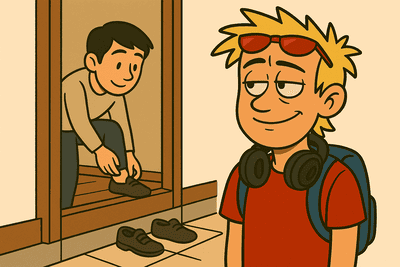If you’ve landed on this page through a search, you probably already know that Japan is a country where people take off their shoes indoors. And yes, that’s absolutely correct.
In Japan, especially in traditional houses and places like temples and shrines, it is customary to take off your shoes at designated areas.
In this article, we’ll first briefly touch on why people take off their shoes (cultural and historical background) and then explain how to do it properly (common pitfalls that might confuse foreign visitors).
Once again, let’s learn from the mishaps of our friend, RedHotRonnie, and explore the common mistakes when it comes to shoe etiquette in Japan.

1. Why Do Japanese People Take Off Their Shoes?
In Japan, the custom of taking off shoes indoors can be broadly attributed to two main factors: cleanliness and the distinction between public and private spaces.
1-1. Cleanliness and Sacred Spaces
In Japan, keeping the interior of the house clean is considered extremely important.
Especially in traditional Japanese houses, people often sit directly on the floor or sleep on futons placed on the floor.
If the floor is dirty, it directly affects daily life.
Therefore, people take off their shoes indoors.
Instead, slippers or indoor shoes are used inside the house to maintain cleanliness.
Moreover, in places like temples and shrines, people also remove their shoes to avoid bringing in “impurity” when entering a sacred space.
This clear distinction between cleanliness and impurity is deeply rooted in the Japanese custom of removing shoes.
From a Japanese perspective, the idea of walking into a house with shoes on might raise a peculiar concern – something like,
“What if you accidentally stepped on a fake dog poop outside?”

1-2. Public-Private Distinction
Another reason is the cultural norm of clearly separating public spaces from private spaces.
By taking off shoes at the entrance, one moves from a public area to a private, relaxing space.

1-3. Other Reasons
There is also a theory related to Japan’s hot and humid climate.
Wearing shoes for a long time can cause unpleasant smells or even lead to athlete’s foot.
Indeed, if you keep your shoes on for too long, well, you know, it does get a bit… unpleasant.

2. Shoe Etiquette Mistakes Foreigners Often Make
2-1. Entering a House with Shoes On
Here comes RedHotRonnie, stepping into a traditional Japanese house for the first time…

Manner #1: “Take off your shoes indoors”
This is the most fundamental rule. It’s the “1” of “1, 2, 3…” and the “A” of “A, B, C…”
When entering a house or a room in Japan, always take off your shoes.
Ronnie’s Comment:
Even if my shoes aren’t dirty, taking them off is my duty…
2-2. Taking Off Shoes When You Don’t Need To
Having learned the rule about taking off shoes indoors, RedHotRonnie now faces his next challenge…

Manner #2: “Don’t take off your shoes where you don’t need to”
This is essentially the flip side of the first rule, but it’s easy to mistakenly take them off anyway.
So, what should you do in these situations?
Let me put it in a very straightforward way:
“You might get scolded for stepping inside with shoes on, but you’ll hardly ever get scolded for taking them off by mistake.”
Ronnie’s Comment:
Finally got that rule down, but now they’re saying I got it all turned around…
2-3. Not Arranging Your Shoes Properly

Manner #3: “Arrange your shoes facing outward after taking them off”
If your shoes look like they’re ready to dance or perform acrobatics after you take them off, some people might think you’re a bit careless.
The proper way is to face the entrance as you take off your shoes, and then turn them around so they point toward the door.
By the way, there’s a subtle rule when visiting shrines and temples: you shouldn’t turn your shoes around after taking them off.
This is because turning your shoes might mean showing your backside to the deity or Buddha, which is considered disrespectful.
However, not many Japanese people are actually aware of this rule.
So as a general guideline, just remember to arrange your shoes neatly when entering a building.
You’ll rarely go wrong with that approach.
To be honest, not all Japanese people are strict about this.
Some laid-back individuals just leave their shoes as they are.
Though, to be fair, you won’t see many adults leaving their shoes flipped over.
For foreigners, it’s not an absolute rule to follow, and no one will judge you harshly if you don’t do it.
However, if you do manage to arrange your shoes properly, people might say,
“Wow, you really know your way around Japan!”
Ronnie’s Comment:
When my shoes start to dance, my heart doesn’t stand a chance…
2-4. Going Outside in Indoor Slippers
After successfully taking off his shoes and stepping inside, RedHotRonnie comfortably puts on his slippers… but then, oops…

Manner #4: “Don’t go outside wearing indoor slippers”
Just as you shouldn’t wear shoes indoors, you shouldn’t go outside wearing indoor slippers.
That’s it!
Well, it’s true, but let’s be honest: even some absent-minded Japanese people (like me) occasionally make this mistake.
For example, stepping outside wearing slippers from a store or a ryokan – it happens more often than you might think.
If you realize it (or if someone points it out), just say, “Sorry!” and switch back.
That’s what I do too.
Ronnie’s Comment:
If I mess up, I say I’m sorry – that’s just my story…
2-5. Stepping on the Threshold

Manner #5: “Don’t step on the threshold”
This is actually a rather obscure rule, and it might just be the No.1 least-known etiquette even among Japanese people.
The “threshold” refers to the boundary that separates spaces (like between rooms or between inside and outside).
It could be the rail of a sliding door, a small step at the entrance, or even the edge of a tatami mat.
While it’s best to avoid stepping on it, being strict about things like not stepping on tatami edges is quite difficult.
In the end, what matters most is showing that you’re aware of the custom, rather than achieving perfection.
And no, that’s not just my personal excuse.
Ronnie’s Comment:
If I don’t cross the border line, everyone’s gonna be just fine…
3. How to Get Shoe Etiquette Right in Japan
3-1. Places Where You Should Remove Your Shoes
You might find it challenging to determine where you should take off your shoes and where it’s okay to keep them on.
In fact, even Japanese people sometimes get confused, so it’s not just you.
However, if you remember some basic rules, you’ll be fine in most situations.
- At the entrance of a Japanese-style house
- When entering the main hall of a shrine or temple
- At the entrance of a traditional inn (ryokan)
- At the “doma” area of a hotel room (Note: Some hotels don’t require you to take off your shoes except on the bed)
Even with these guidelines, it might still seem confusing.
But there are a few clues you can use to figure it out:
- There are slippers (indoor footwear) placed at the entrance
- You see a shoe rack or shoe cabinet
- There is a step or raised floor at the entrance
- Other Japanese people are taking off their shoes
Perhaps the easiest way to know is just to look around and see if other Japanese people are taking off their shoes!

3-2. How to Use Slippers
When it comes to slippers in Japan, there are two distinct types that are strictly separated.
One is indoor slippers, and the other is toilet slippers.
Mixing them up can be quite unpleasant for others.
(For example, walking into a room with toilet slippers on.)
However, even absent-minded Japanese people like myself sometimes end up wearing toilet slippers indoors… (you can imagine the rest).

4. Conclusion
How was it?
While there are a few rules related to shoes in Japan, the ones that Japanese people strictly follow are:
- Never enter indoors with outdoor shoes
- Never go outside wearing indoor slippers (including not walking indoors with toilet slippers)
As for the other etiquette rules – and even for the absolute must-follow ones mentioned above – if you make a mistake, just honestly say, “Sorry!” and fix it.
No one will hold it against you.
Take it easy and embrace Japan’s unique indoor shoe etiquette!
You might also like:



